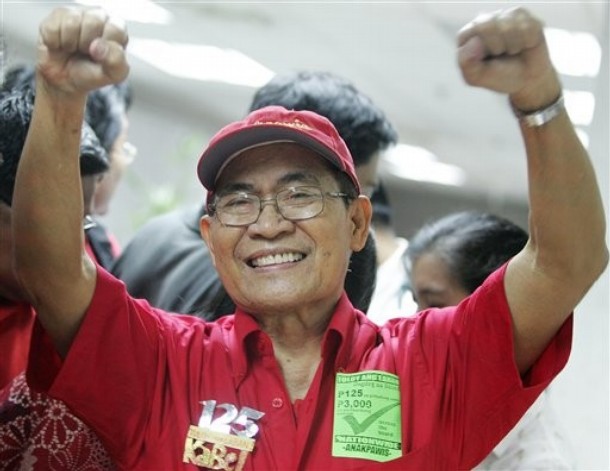
The failures of the political system have turned off many citizens from engaging with it completely. It can be hard not to: we elect politicians to serve the people, when they fail we elect new individuals who promise to be different and when they disappoint us as well it can be tiring to remain optimistic.
Many say they want to change the system, but once elected the system changes them. As that popular Spiderman quote says: “you either die a hero or live to see yourself become the villain.”
Very few in Philippine history can say they entered politics principled and leave politics with those principles unscathed. One of which would have to be the late congressman and labour union leader, Crispin “Ka Bel” Beltran, who died on the 20th of May 2008.
Beltran, or “Ka Bel” as he was fondly called by his peers, was first elected as a congressman in 2001. His election was a result of his party-list, Bayan Muna, receiving the highest number of votes out of any political party in that election. Prior to that achievement, left-wing activist parties were regarded to have no chance of winning.
During his tenure he was consistently ranked the poorest member of Congress based on his declared SALN. People in today’s materialistic world would ridicule that fact, but “Ka Bel” held that title with great pride. And he was right to be proud of that feat, politics of today has seemingly become a cash cow for struggling celebrities unable to find work or for oligarchical families wanting to protect their business interests.
For Beltran, the only reward he sought in his time in office was to help the working class Filipino household. He proved this with the sheer amount of measures he passed during his time in office, with 130 filed in his final stint in office. Among these included bills aiming to introduce a standard minimum wage in the country, a repeal of the neoliberal Electric Power Industry Reform Act (EPIRA) and to forward agrarian reform.

It made sense that his policy agenda resonated well with the working class, Ka Bel was born to a farming family in the 30’s. At the age of ten, he worked as a messenger boy for guerrilla forces during the Japanese occupation.
After the war, he would do a balancing act between his studies and work. While earning a livelihood working at a petrol station, as a farmhand and as a janitor he would also complete his studies, finishing elementary at the late age of 16 years old. In his twenties, Beltran drove a taxi for a living while at the same time pursuing college education at the University of the Philippines Asian Labour Education Center.
He was a unionist affiliated with the Yellow Taxi Drivers Union from 1955-1963, he also became their president. Other unions he associated with included the Philippine Alliance of Nationalist Organizations (PANO) and the Confederation of Labour Unions (CLU). During the Marcos dictatorship, Ka Bel would lead these various activist groups in protest against the government and firsthand experienced the brutality of state forces.
It was also during the dictatorship when Ka Bel learnt of the sacrifices that the defense of democracy entailed. In 1982, he was imprisoned for the crime of sedition as Marcos looked to silence his critics. He would escape in a James Bond-esque manner in 1984.
While granted prison leave to attend his nephew’s birthday party, Beltran colluded with his wife, Rosario “Ka Osang” Soto, to distract his prison guards as he discreetly escaped from a gap in the wall of his nephew’s bathroom. He would be in hiding, being safeguarded by underground communist organizations, until the Marcos regime fell in 1986.

Despite the trauma of being tortured by the Marcos regime, Beltran wasted no time getting back into activism. It was in 2001 when he decided to bring his brand of activism to the legislative level. He would also find a new enemy during that decade, in the person of President Gloria Arroyo. Thanks to his vocal opposition did he land himself in the familiar grasp of prison after being charged with sedition, again, by the President.
However, this time around Ka Bel did not find help only from his relatives against political persecution – a total of 99 parliamentarians from eleven different countries around the world came to his aide, calling for his immediate release. It was proof that his activism was noticed, and appreciated, worldwide.
Hence the reason why many mourned for his death in 2008, after falling 14 feet from his rooftop. Beltran was trying to fix the leak in his dilapidated home, when he accidentally fell to his death. It was a fitting way to go for a working class hero like Ka Bel, an evidence that in the greedy world of politics there are still those who manage to retain their principles.
In response to his death, the Office of the President released a statement mourning for Beltran’s death despite having imprisoned him years earlier. He was called “one of the most respected labor leaders in the country” and a “vital figure” in Philippine labor in that statement, recognizing him for his work.
At a time of contractualization and of widespread exploitation of farm workers, the Philippine labour movement needs a Ka Bel deeply. Though the flames of activism still ignites in the country today, it might never again reach the same level which Crispin Beltran’s passion burnt.
May his legacy live on.

